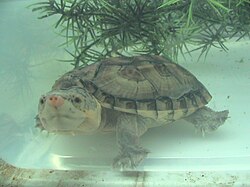| Giant musk turtle | |
|---|---|
 | |
| Staurotypus salvinii in an aquarium | |
| Scientific classification | |
| Domain: | Eukaryota |
| Kingdom: | Animalia |
| Phylum: | Chordata |
| Class: | Reptilia |
| Order: | Testudines |
| Suborder: | Cryptodira |
| Family: | Kinosternidae |
| Genus: | Staurotypus |
| Species: | S. salvinii |
| Binomial name | |
| Staurotypus salvinii Gray, 1864 | |
| Synonyms [2] | |
| |
The giant musk turtle (Staurotypus salvinii) , also known commonly as the Chiapas giant musk turtle or the Mexican giant musk turtle , is a species of turtle in the family Kinosternidae. The species is found in Central America.
